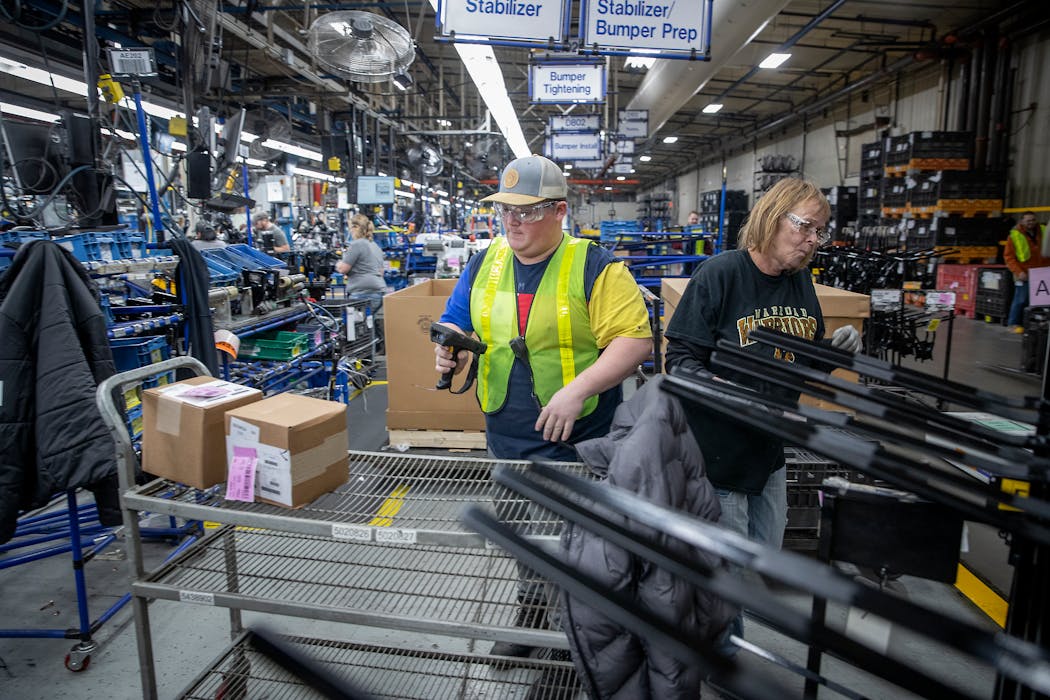Polaris Industries, with a near record backlog of recreational vehicles and dealers begging for more, is calling in its own "SWAT teams" — what it calls employees trying to solve supply chain problems.
In an age when it is taking additional months to get essential parts for everything from recreational vehicles and retail goods to industrial filters and medical devices, Minnesota companies are throwing all the resources they can at the problem and hoping customers will understand the higher prices that result.
The problems — along with inflation on core materials such as steel and increased wages — added $100 million in costs to Polaris' first-quarter operations. They added hundreds of millions to Target's costs.
And it caught up to most Minnesota public companies' profitability, either denting their earnings or profit margins. Target had a huge earnings miss Wednesday, triggering a freefall in the markets as investors worried about what it all means for the long term.
For the companies, it means working even harder to make operations more efficient, simplifying product designs to work around the parts shortages and finding better and more suppliers, preferably ones closer to their factories.
"The reality is, it isn't going to get better anytime soon," said Polaris Chief Executive Mike Speetzen. "And so we're making a lot of those organizational moves more permanent. And that allows us to make sure we've got the right staffing and the folks that can drive the kind of hour-to-hour discussions that we've got to have with our suppliers."
The good news — at least for now — is that people are still buying, even if they have to preorder all-terrain vehicles, cars or mattresses and wait several months for delivery. That means companies that provide industrial filters, adhesives and other products that go into those products also are running at overtime to keep up with orders.
Many Minnesota companies also came into the year with good balance sheets — having cut back where possible and loosened cash positions at the beginning of the pandemic, said Carol Schleif, the Minneapolis-based deputy chief investment officer for BMO Family Office. As a result, they have money to invest in solutions.
"What we sometimes forget is how resilient our companies were," she said. "They prepared for a recession. The recession happened for a few months, [and when they had to] companies changed business models quickly."
For example, UnitedHealth Group, which leads the Star Tribune 50 list of Minnesota public companies, saw its revenue grow 11.8% last year to $287.6 billion. The company's guidance for this year has revenue between $317 billion and $320 billion.
In total, the 50 companies on the list earned $58.9 billion, a rise of 36% from 2020, on total revenue that grew 13% to $705 billion. In a pandemic economy that was uneven, 15 of the companies saw profit declines for the four quarters that ended closest to Dec. 31.
As Target officials predicted lower operating margins for the year, they stressed the company's financial health, emphasizing its balance sheet.
"As we navigate these near-term challenges, we are fortunate to have an incredibly healthy underlying business, one that can stand up to the significant headwinds we're facing and come out stronger on the other side," said Chief Financial Officer Michael Fiddelke on the earnings call.
But in the near term, Target CEO Brian Cornell said, the company will have to "be balanced" in any price increases and forgo some profits to keep market share while inflationary pressures add about $1 billion to costs this fiscal year.
Target has learned to be more nimble during the pandemic as consumer preferences changed, sometimes month to month. The company at times had to charter its own cargo ships to circumvent supply-chain clogs.
As the pandemic accelerated changes to how people shop, in a similar way, shifts in the global supply chain have quickened. China's zero-tolerance policy on COVID-19, which has at times shut down its manufacturing sectors for weeks at a time, and the Russian invasion of Ukraine have exacerbated companies' moves to spread their supply chain over more geographic areas.
To react, the Polaris "SWAT teams" are communicating with suppliers all over the globe, including new back-up vendors in different countries. Other teams are redesigning products to simplify them or to use a different part that the company can get, and redoing operational schedules so they are in sync when shipments are ready.
3M said it is using more real-time data analytics. Bloomington-based Donaldson is starting to build up parts inventories as it can get them and switching to suppliers closer to its factories.
Andrew Adams, chief investment officer at Mairs & Power in St. Paul, said that before the pandemic, companies usually had a solid back-up supplier in case there was an emergency like a fire or burst pipe. Now, they have three or four.
Technology company Jaggaer surveyed Mexican suppliers, who said from 2020 to 2021 they received 514% more bids from big U.S. buyers, according to the Wall Street Journal. Latin American suppliers saw a 155% increase. At the same time, orders to Chinese suppliers dropped 9%.
Advances in automation, driven by the worker shortage, also will help Minnesota companies improve internal efficiencies and buy lower-price components closer to home, Schleif said.
Donaldson, like many companies, takes that a bit further with what is called the "golden screw" concept. The global manufacturer of filtration products with locations in more than 40 countries tries to keep regional suppliers for each of its locations.
The company also has been building up parts inventories, moving away from the strict pre-pandemic "lean manufacturing" that focused on ordering only as much volume as was needed in a given week or month. Now when delayed parts arrive, increased inventories allow them to finish manufacturing processes faster.
In the quarter ended Jan. 31, the company increased inventories by 8%, or $36 million, said Sarika Dhadwal, Donaldson's director of investor relations. It also covered increased costs with higher than normal January price increases, and updated its global enterprise resource planning system, she said.
Vigilance and communication are particularly important.
"Leveraging the power of daily management, data and data analytics" while also making operations more efficient is key, said Monish Patolawala, chief financial officer of 3M.
"Last year, we developed new sourcing and pricing tools and processes to improve agility, drive alignment and simplify our processes," he said in April during the company's latest quarterly earnings call. "In addition, we are also enhancing our reporting and data analytics capabilities by rolling out tools that model price realization, leakage and elasticity."
That operational efficiency is essential for industries where price increases can sometimes only be minimal, said Frank Jaskulke, vice president of intelligence for Medical Alley.
For the state's medical companies, it's not as easy to manage on the fly. Component design — even of parts — might be part of the regulatory approval of the product, making finding a new supplier harder, Jaskulke said.
So cross-company groups similar to Polaris' SWAT teams have been working throughout Medical Alley on the supply-chain issue. The smaller companies don't run manufacturing lines every day. One company received the critical parts needed for a manufacturing run — which would have been cost-prohibitive to cancel — two hours before the machines started.
Keeping efficiencies — and adding even more — are necessary because medical companies do not have as much leverage with price increases, he said. Many are set in insurance plans and hospital contracts.
Myles Shaver, a professor of strategic management and entrepreneurship at the University of Minnesota Carlson School of Business, said global trade will not "settle into a new normal immediately" and will hit intermittent pockets of supply-chain problems for the next few years.
So companies will adapt, he said, just like they made changes during the energy crisis of the 1970s and early 1980s.
"They evolve," Shaver said. "And some of the changes they have made, they see them staying long-term."
There are plenty of factors that could derail improvements in the supply chain.
West Coast unionized dockworkers and cargo-handling companies started negotiating new contracts this month. China still has restrictions in place because of COVID-19. And the war in Ukraine is far from over.
But even if the supply chains improve, inflationary pressure will remain. The prices companies are paying for parts are not likely to go back down, Schleif said. The same goes for workers' wages.
"The higher prices right now are in sticky places," Schleif said.
Those factors have resulted in varied opinions on how inflation will affect the overall economy over the next few years, ranging from staying steady to stagflation with lower growth or recession. The uncertainty has the markets on edge, as evidenced after Target's earnings report.
The key question, economists said, is whether demand will stay strong. If it doesn't, there will be pressure on pricing, the one factor manufacturers have been able to rely upon in the last year to cover much of the rising costs.
Speetzen for one is getting the message that it will.
"We survey our dealer network each quarter, and there was one dealer comment that I felt summed up the current environment well: 'My business is thriving. Send us inventory, and we'll take care of the rest,'" Speetzen said on the company's earnings call. "This, to me, points to a healthy demand environment that is ripe for growth once we work through the current supply-chain environment."




